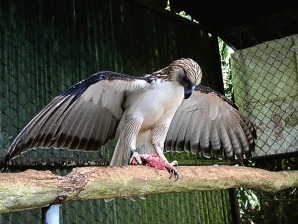In The Know: Philippine Eagle

WINGED VICTORY. The Philippine Eagle’s wing span of 7 feet is world’s broadest. Pag-asa shows off at the eagle sanctuary in Davao City. EDDIE JUNTILLA/PHILIPPINE EAGLE
MANILA, Philippines—“Pag-asa” was conceived through artificial insemination and was laid in November 1991 by captive Philippine Eagle Diola using mate Junior’s semen.
It was Diola’s fourth fertile egg and the first to hatch.
The severe power crisis in Mindanao threatened the egg’s survival, with the generator that automatically provided electricity during power outages conking out once every four hours.
Then Eagle Camp manager Domingo Tadena and his staff had to wrap the egg in a water-filled rubber pack, the temperature of which was carefully calculated and maintained.
A quake also briefly threatened Pag-asa’s survival, as did an apparent thinning of the egg. The timely application of colorless nail polish proved effective in hardening the shell.
Pag-asa’s eventual hatching in 1992 was the result of 10 years of research and experimentation on the country’s national bird.
American Express Bank adopted Pag-asa in 1992 and has been providing financial aid to the Philippine Eagle Foundation (PEF), a Davao-based nonprofit, nongovernment organization dedicated to saving the endangered species and its rainforest habitat.
Before Pag-asa, only 37 eagles had been identified to exist in the Philippines—13 in captivity and 24 associated with wild nests.
As part of the efforts to boost the dwindling eagle population in the wild, Kabayan, an eagle also bred and hatched in captivity, was released to the wild in 2004—the first captive-bred eagle thus released.
The Philippine Eagle is a 3-foot-high rainforest raptor with a wingspan of 7 ft—the broadest in the world. Deforestation and hunting have threatened its survival.
It is estimated that only 400 pairs of these eagles remain in the islands of Luzon, Samar, Leyte and Mindanao. Thirty-six eagles, 18 of them bred in captivity, are housed at the PEF Center located at the foothills of Mt. Apo in Davao. Ana Roa, Inquirer Research
Source: Inquirer Archives














